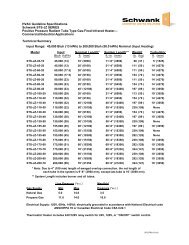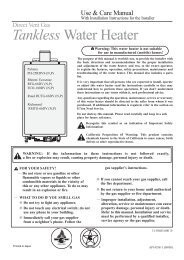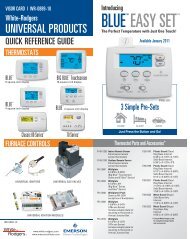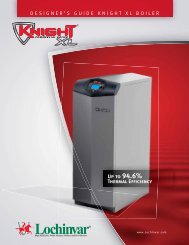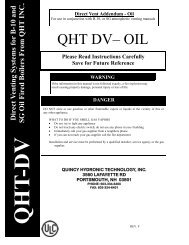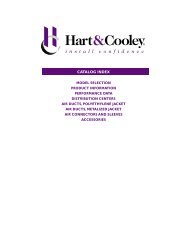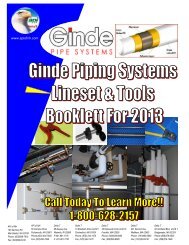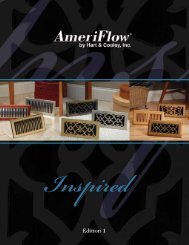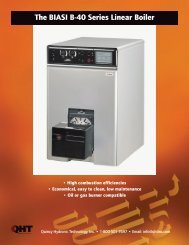- Page 2 and 3: Table of Contents (Hydronic)About U
- Page 4 and 5: Table of Contents (Direct Expansion
- Page 6 and 7: About UsSetting new industry standa
- Page 9 and 10: Ductless and Ducted Hydronic Air Co
- Page 11 and 12: DX Product OverviewDX Fan Coils are
- Page 13 and 14: January 2008Multiaqua Equipment Sou
- Page 15 and 16: MAC120 NOMENCLATURE BREAKDOWNMAC120
- Page 17 and 18: F. Pump:1. Unit shall be capable of
- Page 19 and 20: MAC120 Product SpecificationsMAC120
- Page 21: MAC120 Cooling Performance DataMAC1
- Page 24 and 25: Multiaqua Chiller ManualThe Multiaq
- Page 26 and 27: ELECTRICAL AND PHYSICAL DATAThe inf
- Page 28 and 29: Description of Electrical ControlsC
- Page 30 and 31: Chiller Controls Sequence of Operat
- Page 32 and 33: Description Of Refrigerant Componen
- Page 34 and 35: Composite Piping Layout and DesignU
- Page 38 and 39: Filling System with Liquid Solution
- Page 40 and 41: MAC120-3 Wiring Diagram380/460-3-50
- Page 42 and 43: MAC120-2 Ladder Wiring Diagram208/2
- Page 44 and 45: MAC120-2-L with Low Ambient Kit Wir
- Page 46 and 47: MAC120-1 Wiring Diagram208/230-1-50
- Page 48 and 49: MAC120 CERTIFIED DRAWING43
- Page 50 and 51: MAC036,048 & 060 NOMENCLATURE BREAK
- Page 52 and 53: F. Pump:1. Circulating pump shall b
- Page 54 and 55: MAC036, 048 & 060 Product Specifica
- Page 56 and 57: MAC036 Cooling Performance DataMAC0
- Page 58 and 59: MAC048 Cooling Performance DataMAC0
- Page 60 and 61: MAC060 Cooling Performance DataLWT
- Page 63 and 64: Table of ContentsPageIntroduction 5
- Page 65 and 66: System Description & Sequence of Op
- Page 67 and 68: Consult local building codes or ord
- Page 69 and 70: Description of Electrical Controls
- Page 71 and 72: SYSTEM FAULTS:Flow Switch Opening:
- Page 73 and 74: Piping System ComponentsSupply Stor
- Page 75 and 76: An adjustable valve must be used to
- Page 77 and 78: To not engage in cold ambient mitig
- Page 79 and 80: MAC060-3 Ladder Wiring Diagram380/4
- Page 81 and 82: MAC060-3-L with Low Ambient Kit Wir
- Page 83 and 84: MAC036, 048 & 060-2 Wiring Diagram2
- Page 85 and 86: MAC036, 048 & 060-1 Ladder Wiring D
- Page 87 and 88:
MAC036, 048 & 060-1-L with Low Ambi
- Page 89 and 90:
MHCCW Chilled Water Ceiling Conceal
- Page 91 and 92:
HVAC Guide SpecificationsChilled Wa
- Page 93 and 94:
ModelNumberHeight(in)MHCCW Product
- Page 95 and 96:
MHCCW Chilled Water Performance Dat
- Page 97 and 98:
MHCCW Chilled Water Performance Dat
- Page 99 and 100:
MHCCW Hot Water Performance DataMHC
- Page 101 and 102:
MHCCW Hot Water Performance DataMHC
- Page 104 and 105:
MHCCW Hot Water Performance DataMHC
- Page 106 and 107:
MHCCW CFM and Glycol AdjustmentsCFM
- Page 108 and 109:
102
- Page 110 and 111:
INSTALLATION & OPERATINGINSTRUCTION
- Page 112 and 113:
INSTALLATION & OPERATINGMANUALMHCCW
- Page 114 and 115:
INSTALLATION & OPERATINGMANUALMHCCW
- Page 116 and 117:
INSTALLATION & OPERATIONMANUALMHCCW
- Page 118 and 119:
INSTALLATION & OPERATIONMANUALMHCCW
- Page 120 and 121:
MHCCW With Electric Heat Wiring Dia
- Page 122 and 123:
MHCCW CERTIFIED DRAWING116
- Page 124 and 125:
MHNCCW NOMENCLATURE BREAKDOWN4-Pipe
- Page 126 and 127:
Part 3-Controls and Safeties3.01 Co
- Page 128 and 129:
MHNCCW Chilled Water Performance Da
- Page 130 and 131:
MHNCCW Chilled Water Performance Da
- Page 132 and 133:
MHNCCW Chilled Water Performance Da
- Page 134 and 135:
MHNCCW Hot Water Performance DataEN
- Page 136 and 137:
MHNCCW Hot Water Performance DataEN
- Page 138 and 139:
MHNCCW CFM and Glycol AdjustmentsNo
- Page 140 and 141:
134
- Page 142 and 143:
INSTALLATION & OPERATINGINSTRUCTION
- Page 144 and 145:
INSTALLATION & OPERATINGMANUALMHNCC
- Page 146 and 147:
INSTALLATION & OPERATINGMANUALMHNCC
- Page 148 and 149:
INSTALLATION & OPERATIONMANUALMHNCC
- Page 150 and 151:
INSTALLATION & OPERATIONMANUALMHNCC
- Page 152 and 153:
MHNCCW-xx-03 Wiring Diagram120-1-60
- Page 154 and 155:
MHNCCW CERTIFIED DRAWING147
- Page 156 and 157:
MCCW NOMENCLATURE BREAKDOWN2-Pipe H
- Page 158 and 159:
Part 3-Controls and Safeties3.01 Co
- Page 160 and 161:
MCCW Chilled Water Performance Data
- Page 162 and 163:
MCCW Hot Water Performance DataMCCW
- Page 164 and 165:
MCCW CFM and Glycol AdjustmentsNomi
- Page 166 and 167:
INSTALLATION & OPERATINGMANUALMCCW
- Page 168 and 169:
INSTALLATION & OPERATINGMANUALMCCW
- Page 170 and 171:
INSTALLATION & OPERATINGMANUALMCCW
- Page 172 and 173:
INSTALLATION & OPERATIONMANUALMCCW
- Page 174 and 175:
INSTALLATION & OPERATIONMANUALMCCW
- Page 176 and 177:
MCCW-xx-01 Wiring Diagram208/230-1-
- Page 178 and 179:
MHWW Chilled/Hot WaterHi-Wall Fan C
- Page 180 and 181:
HVAC Guide SpecificationsChilled an
- Page 182 and 183:
MHWW Product SpecificationsModel Nu
- Page 184 and 185:
MHWW Chilled Water Performance Data
- Page 186 and 187:
MHWW Chilled Water Performance Data
- Page 188 and 189:
MHWW Hot Water Performance DataMHWW
- Page 190 and 191:
MHWW Hot Water Performance DataMHWW
- Page 192 and 193:
MHWW Hot Water Performance DataMHWW
- Page 194 and 195:
187
- Page 196 and 197:
INSTALLATION & OPERATINGMANUALMHWW
- Page 198 and 199:
INSTALLATION & OPERATINGMANUALMHWW
- Page 200 and 201:
INSTALLATION & OPERATINGMANUALMHWW
- Page 202 and 203:
INSTALLATION & OPERATINGMANUALMHWW
- Page 204 and 205:
INSTALLATION & OPERATINGMANUALMHWW
- Page 206 and 207:
INSTALLATION & OPERATINGMANUALMHWW
- Page 208 and 209:
INSTALLATION & OPERATINGMANUALMHWW
- Page 210 and 211:
MHWW-18-H-1 Wiring Diagram208/230/-
- Page 212 and 213:
MHWW-36-H-1 Wiring Diagram208/230/-
- Page 214 and 215:
CFFWA Chilled/Hot WaterUniversal Mo
- Page 216 and 217:
HVAC Guide SpecificationsChilled an
- Page 218 and 219:
CFFWA Product SpecificationsModel N
- Page 220 and 221:
CFFWA Chilled Water Performance Dat
- Page 222 and 223:
CFFWA Chilled Water Performance Dat
- Page 224 and 225:
CFFWA Chilled Water Performance Dat
- Page 226 and 227:
CFFWA Hot Water Performance DataCFF
- Page 228 and 229:
CFFWA Hot Water Performance DataCFF
- Page 230 and 231:
CFFWA Hot Water Performance DataCFF
- Page 232 and 233:
CFFWA CFM and Glycol AdjustmentsCAP
- Page 234 and 235:
INSTALLATION & OPERATINGMANUALCFFWA
- Page 236 and 237:
INSTALLATION & OPERATINGMANUALCFFWA
- Page 238 and 239:
INSTALLATION & OPERATINGMANUALCFFWA
- Page 240 and 241:
CFFWA CERTIFIED DRAWING232
- Page 242 and 243:
CWA2 NOMENCLATURE BREAKDOWN2-Pipe H
- Page 244 and 245:
G. Filters:1. Unit shall contain a
- Page 246 and 247:
CWA2 Chilled Water Performance Data
- Page 248 and 249:
CWA2 Chilled Water Performance Data
- Page 250 and 251:
CWA2 Chilled Water Performance Data
- Page 252 and 253:
CWA2 Hot Water Performance DataENTE
- Page 254 and 255:
CWA2 CFM and Glycol AdjustmentsMode
- Page 256 and 257:
CWA2 Capacity Adjustment FactorsCWA
- Page 258 and 259:
INSTALLATION & OPERATINGMANUALCWA2
- Page 260 and 261:
INSTALLATION & OPERATINGMANUALCWA2
- Page 262 and 263:
INSTALLATION & OPERATINGMANUALCWA2
- Page 264 and 265:
INSTALLATION & OPERATINGMANUALCWA2
- Page 266 and 267:
CWA2 CERTIFIED DRAWING258
- Page 268 and 269:
CWA4 NOMENCLATURE BREAKDOWN4-Pipe H
- Page 270 and 271:
G. Filters:1. Unit shall contain a
- Page 272 and 273:
CWA4 Chilled Water Performance Data
- Page 274 and 275:
CWA4 Chilled Water Performance Data
- Page 276 and 277:
CWA4 Hot Water Performance Data24CW
- Page 278 and 279:
CWA4 Capacity Adjustment FactorsCWA
- Page 280 and 281:
INSTALLATION & OPERATINGMANUALCWA4
- Page 282 and 283:
INSTALLATION & OPERATINGMANUALCWA4
- Page 284 and 285:
INSTALLATION & OPERATINGMANUALCWA4
- Page 286 and 287:
INSTALLATION & OPERATINGMANUALCWA4
- Page 288 and 289:
CWA4 CERTIFIED DRAWING280
- Page 290 and 291:
MHCCX NOMENCLATURE BREAKDOWNDirect
- Page 292 and 293:
G. Electric Heat:1. Electric Heater
- Page 294 and 295:
MHCCX Product SpecificationsElectri
- Page 296 and 297:
MHCCX CFM AdjustmentsCFM vs. Extern
- Page 298 and 299:
INSTALLATION & OPERATINGMANUALMHCCX
- Page 300 and 301:
INSTALLATION & OPERATINGMANUALMHCCX
- Page 302 and 303:
INSTALLATION & OPERATINGMANUALMHCCX
- Page 304 and 305:
INSTALLATION & OPERATIONMANUALMHCCX
- Page 306 and 307:
INSTALLATION & OPERATIONMANUALMHCCX
- Page 308 and 309:
MHCCX Without Electric Heat Wiring
- Page 310 and 311:
MHCCX with 2KW Electric Heat Wiring
- Page 312 and 313:
MHCCX CERTIFIED DRAWING304
- Page 314 and 315:
MCCX NOMENCLATURE BREAKDOWNDirect E
- Page 316 and 317:
Part 3-Controls and Safeties3.01 Co
- Page 318 and 319:
310
- Page 320 and 321:
INSTALLATION & OPERATINGINSTRUCTION
- Page 322 and 323:
INSTALLATION & OPERATINGMANUALMCCX
- Page 324 and 325:
MHCCX Without Electric Heat Wiring
- Page 326 and 327:
MHNCCX DX with Hot Water HeatCeilin
- Page 328 and 329:
HVAC Guide SpecificationsDirect Exp
- Page 330 and 331:
MHNCCX Product SpecificationsPhysic
- Page 332 and 333:
MHNCCX Heating Capacity Adjustment
- Page 334 and 335:
MHNCCX Hot Water Performance DataEN
- Page 336 and 337:
MHNCCX Hot Water Performance DataEN
- Page 338 and 339:
330
- Page 340 and 341:
INSTALLATION & OPERATINGINSTRUCTION
- Page 342 and 343:
INSTALLATION & OPERATINGMANUALMHNCC
- Page 344 and 345:
INSTALLATION & OPERATINGMANUALMHNCC
- Page 346 and 347:
INSTALLATION & OPERATIONMANUALMHNCC
- Page 348 and 349:
INSTALLATION & OPERATIONMANUALMHNCC
- Page 350 and 351:
MHNCCX-xx-03 Wiring Diagram120-1-50
- Page 352 and 353:
MHWX Direct ExpansionHi-Wall Fan Co
- Page 354 and 355:
HVAC Guide SpecificationsDirect Exp
- Page 356 and 357:
MHWX Product Specifications & Capac
- Page 358 and 359:
INSTALLATION & OPERATINGMANUALMHWX
- Page 360 and 361:
INSTALLATION & OPERATINGMANUALMHWX
- Page 362 and 363:
INSTALLATION & OPERATINGMANUALMHWX
- Page 364 and 365:
INSTALLATION & OPERATINGMANUALMHWX
- Page 366 and 367:
INSTALLATION & OPERATINGMANUALMHWX
- Page 368 and 369:
INSTALLATION & OPERATINGMANUALMHWX
- Page 370 and 371:
INSTALLATION & OPERATINGMANUALMHWX
- Page 372 and 373:
MHWX-18-H-1 Wiring Diagram208/230/-
- Page 374 and 375:
MHWX-36-H-1 Wiring Diagram208/230-1
- Page 376 and 377:
MHWX-18-C-1 Wiring Diagram208/230/-
- Page 378 and 379:
MHWX-36-C-1 Wiring Diagram208/230-1
- Page 380 and 381:
FSFCA Direct ExpansionUniversal Mou
- Page 382 and 383:
HVAC Guide SpecificationsDirect Exp
- Page 384 and 385:
FSFCA Product Specifications & Capa
- Page 386 and 387:
INSTALLATION & OPERATINGMANUALFSFCA
- Page 388 and 389:
INSTALLATION & OPERATINGMANUALFSFCA
- Page 390 and 391:
INSTALLATION & OPERATINGMANUALFSFCA
- Page 392 and 393:
FSFCA CERTIFIED DRAWING384
- Page 394 and 395:
42 Gallon Liquid Solution Storage T
- Page 396 and 397:
Bypass Control ValveThe Honeywell b
- Page 398 and 399:
3-Way Motorized Zone ValvesThe Erie
- Page 400 and 401:
Multiaqua ThermostatThe Multiaqua t
- Page 402 and 403:
Wireless ThermostatThe wireless 24v
- Page 404 and 405:
Circulating PumpsThe Gould MCS Seri
- Page 406 and 407:
Circulating PumpsThe American Stain
- Page 408 and 409:
ASSEMBLY & INSTALLATIONINSTRUCTIONS
- Page 410 and 411:
MPE468(L/NL), MPE10(L/NL), MPE12(L/
- Page 412 and 413:
MPE468(L/NL), MPE10(L/NL), MPE12(L/
- Page 414 and 415:
MPE468(L/NL), MPE10(L/NL), MPE12(L/
- Page 416 and 417:
Banked Chiller ConfigurationThese s
- Page 418:
Chilled Water Air Conditioning Syst



